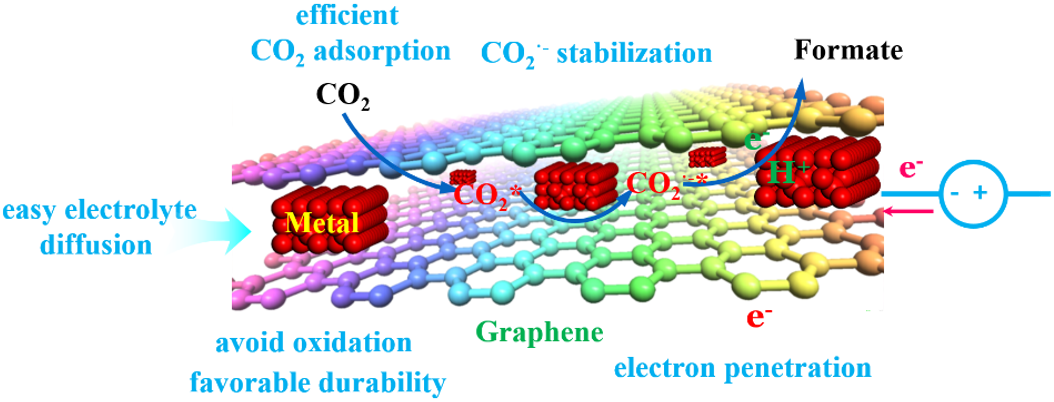Metallic Tin Quantum Sheets Confined in Graphene toward High-efficiency Carbon Dioxide Electroreduction
Prof. Yi Xie and Prof. Yongfu Sun’s group from Hefei National Laboratory for Physical Sciences at the Microscale (HFNL) in the University of Science and Technology of China (USTC) has recently achieved new progress in the field of synthesis and properties of metallic ultrathin two-dimensional structure. This work has been published in Nature Communications with the title of "Metallic Tin Quantum Sheets Confined in Graphene toward High-efficiency Carbon Dioxide Electroreduction ".
As is well-known, the excessive utilization of fossil fuels led to the increasing energy crisis and the worsening global climate, which triggered tremendous attention at CO2 capture, storage and utilization. To figure out these issues, electrocatalytic reduction of CO2 into hydrocarbon fuels is considered as a promising strategy, which can not only dealing with increasing CO2 adverse effects on climate but also provide new approach to solve the energy crisis. Metal electrodes, benefiting from high electronic conductivity, show considerable catalytic activities toward CO2 electroreduction. However, the practical applications of these metal electrodes are greatly hindered by the very low energetic efficiencies, which could be ascribed to their extremely low amount of catalytically active sites. It’s reported that the ultrathin layers of metallic Co exhibit significant activities in electrocatalytic reduction of CO2. Nevertheless, for some metals with higher chemical reactivity, while exposing ultrahigh amount of surface atoms, they tend to be very unstable at ambient conditions and will be oxidized in a non-controlled manner, which would lead to the loss of electronic conductivity and consequently cause a rapid decay in the electrocatalytic activities.
To address the above question, Prof. Yi Xie and Prof. Yongfu Sun’s group constructs an ideal model of graphene confined ultrathin layers of highly reactive metals for the first time. As an example, highly reactive Sn quantum sheets confined in graphene are synthesized via a spatially confined reduction strategy. Collaborated with Prof. Shiqiang Wei and Prof. Tao Yao in National Synchrotron Radiation Laboratory, they apply synchrotron radiation XAFS to resolve the fine structure of the-obtained Sn quantum sheets confined in graphene. Take advantage of the protection of graphene, Sn quantum sheets show non oxidized states revealed by XAFS. In addition, the lowered Sn-Sn coordination numbers resulted from XAFS enable Sn quantum sheets confined in graphene to efficiently stabilize the CO2•- intermediate. As a result, the Sn quantum sheets confined in graphene show roughly 2, 2.5 and 13 times larger electrocatalytic activity than the 15 nm Sn nanoparticles mixed with graphene, 15 nm Sn nanoparticles and bulk Sn, while the former also possesses formate Faradaic efficiency of over 85% during the 50-h period. Briefly, the present work demonstrates that the unique structure of highly reactive metal quantum sheets confined in graphene could fully optimize CO2 electroreduction performances, which provides a promising lead for designing efficient and robust catalysts for electrolytic fuel synthesis.

Schematic illustration depicts the several advantages of ultrathin metal layers confined in graphene for CO2 electroreduction into hydrocarbon fuels
This work was financially supported by National Nature Science Foundation, Youth Innovation Promotion Association of CAS, the Fundamental Research Funds for the Central Universities and Scientific Research Grant of Hefei Science Center of CAS.
Publication link: http://www.nature.com/ncomms/2016/160902/ncomms12697/full/ncomms12697.html
Back
